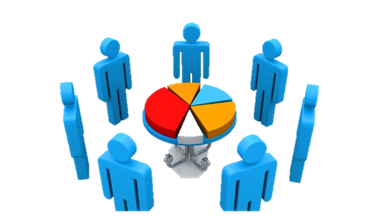3.4.1 Summary
Course subject(s)
Module 3 – Stakeholders and Sectors





Stakeholders vary considerably and can come from the industrial area, e.g. private firms, from the governmental area, e.g. city councils, or from the research area, e.g. universities. As varied as stakeholders are, are their goals. There are two general kinds of goals, i.e. private versus public goals. Organizations pursuing private goals aim at individual advantages, such as private profit or self-employment. Organizations going for public goals target gains for communities of people, such as producing public goods, e.g. by providing an education system. While there are many examples of private or public organizations going for clear-cut private or public goals, in reality we often also encounter organizations pursuing a mixture of private and public goals.
Depending on their goals stakeholders take decisions. To improve their decision making they have increasingly used big data. Whereas in traditional decision-making data has been stored in data warehouses, using big data means that there are multiple sources of heterogeneous data, scattered around many stakeholders, some of them being real-time data with high velocity. To use the various types of data experts have to combine them by complex transformations. Sometimes this is even done externally. Whereas in traditional decision making the same analysis is often repeated, big data requires new analyses every time. This continuous search for new insights complicates the creation of well-defined decision-making processes. Each time other types of data, processing activities and stakeholders might be involved. Every stakeholder might only have a partial picture which makes decision-making so hard. Information might be incorrect, patterns detected might be just noise and do not exist, the situation might have changed in the meantime, the impact might be different than expected, people might resist and so on. Generally speaking, uncertainty is an inherent characteristics of a decision-making process. So, it is important being aware of the quality and problems of the data used as well as having procedures that ensure that decision are taken by the right (group of) people. This is even more the case for decision making based on big data than for traditional decision making, because big data decision-making is a complex socio-technical processes.
A sector, i.e. a subdivision of an economic system, contains stakeholders, their relationships as well as the institutional set-up (e.g. laws, regulations, codes of conduct). When looking at the influence of big data on a sector it is crucial to clarify whether the big data-induced changes will be incremental or disruptive. There are three devastating features that might lead to the disruption of a sector:
- unencumbered development with competitors experimenting endlessly until they find a way to outcompete others
- undisciplined strategy, i.e. not focusing on either better performance, or lower prices or better customization but doing it all at the same time
- unconstrained growth collapsing the known product life cycle into only development, deployment and replacement
Big data-induced changes depend a lot on the sector. The three cases we provide information about are rather different regarding their big data-induced changes. Transportation by shipping is a global sector with a strong existing network and a set of rules that cannot be easily changed. Here, the situation differs considerably from the second case, health, where strong national regulations co-evolve with substantial advancement on a global scale and the need to provide good care for our ageing societies in Western industrialized countries. The third case is even more locally embedded, i.e. Smart Cities, but again influenced a lot by innovation and technological change around the world.
Downes, L., & Nunes, P. F. (2013). Big Bang Disruption. Harvard Business Review(March), 44-56. https://papers.ssrn.com/sol3/papers.cfm?abstract_id=2709801
Janssen, M., Konopnicki, D., Snowdon, J. L., & Ojo, A. (2017). Driving public sector innovation using big and open linked data (BOLD). Information Systems Frontiers, 19(2), 189-195. https://link.springer.com/article/10.1007%2Fs10796-017-9746-2<
Janssen, M., & Kuk, G. (2016). Big and Open Linked Data (BOLD) in research, policy, and practice. Journal of Organizational Computing and Electronic Commerce, 26(1-2), 3-13. http://www.tandfonline.com/doi/abs/10.1080/10919392.2015.1124005
Stilgoe, J., Owen, R., & Macnaghten, P. (2013). Developing a framework for responsible innovation. Research Policy. https://www.sciencedirect.com/science/article/pii/S0048733313000930

Big Data Strategies to Transform Your Business by TU Delft OpenCourseWare is licensed under a Creative Commons Attribution-NonCommercial-ShareAlike 4.0 International License.
Based on a work at https://online-learning.tudelft.nl/courses/big-data-strategies-to-transform-your-business/.



